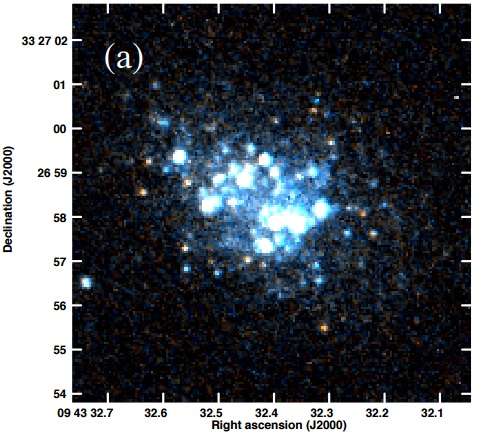March 16, 2016 report
Astronomers discover the most metal-poor galaxy in the local universe

(Phys.org)—Galaxies with low metallicity are of special importance for astronomers as they could provide crucial insights about chemical evolution of stars and astrophysical processes occurring in the early universe. Now, a team of researchers, led by Alec Hirschauer of Indiana University, has detected a galaxy that appears to be the most metal-poor gravitationally bound system of stars present in the local universe. The findings appear in a paper published online on Mar. 11 in the arXiv journal.
The newly discovered galaxy was designated AGC 198691. According to the findings, it is a blue compact dwarf galaxy located within the range of 23 to 52 million light years from the Earth, with a diameter of about 1,000 light years. The brightest stars in AGC 198691 are blue, which causes the galaxy itself to appear blue in color. The system exhibits a compact structure dominated by luminous blue stars presumably produced in recent star-formation processes.
The galaxy was discovered during the Arecibo Legacy Fast ALFA survey (ALFALFA). It is a blind extragalactic survey in neutral atomic hydrogen (HI) utilizing the Arecibo L-Band Feed Array (ALFA) at the Arecibo Observatory in Puerto Rico. The program, started in 2005, aims to find up to 25,000 galaxies, including dark galaxies, consisting largely of dark matter, and which are thus not visible with optical telescopes.
Hirschauer and his colleagues conducted spectroscopic observations to obtain spectra of AGC 198691. To accomplish this task, they employed two Arizona-based telescopes: the Mayall 4-meter telescope at the Kitt Peak National Observatory (KPNO) and the 6.5-meter Multiple Mirror Telescope (MMT). Spectrographs mounted on these telescopes allowed them to derive the chemical composition of AGC 198691, revealing that this system is exceptionally metal-poor.
"We report spectroscopic observations of the dwarf galaxy AGC 198691 that have led to the recognition that it is an extremely metal-deficient galaxy with the lowest abundance ever reported for a gas-rich extragalactic source," the paper reads.
The team's observations revealed that AGC 198691 has a very high abundance of oxygen, thereby having very low metallicity. Moreover, the researchers argue that this level of metallicity makes it the most metal-poor galaxy known in the local universe. They estimate that AGC 198691 possesses a metallicity that is about 29 percent below that of SBS 0335-052W, the galaxy that had previously been recognized as the most metal-poor. It is worth observing that the most metal-poor galaxies known have measured nebular oxygen abundances of about three percent of the solar value.
However, the cause of the low metallicity and gas-rich nature of AGC 198691 is still being debated. One explanation offered by Hirschauer's team is that this system has experienced recent gas infall that has reduced its observed metallicity. The scientists emphasize that in order to better understand this galaxy's true nature, more precise measurements are required, such as determining its exact distance.
"The determination of an accurate distance to AGC 198691 would provide valuable insight into the possible mechanisms at play, since it would allow for a much better understanding of the environment within which this system resides," the astronomers noted.
The team also disclosed its plans for future observations of this system. They would like to use a high-quality follow-up spectrum obtained with the Large Binocular Telescope in Arizona to carry out an analysis of helium abundance of AGC 198691.
"While the spectra in the current study were not suitable for providing an estimate of the helium abundance in this galaxy, we suggest that future observations would very likely be fruitful in yielding an estimate of the primordial helium abundance," the researchers write.
More information: ALFALFA Discovery of the Most Metal-Poor Gas-Rich Galaxy Known: AGC 198691, arXiv:1603.03798 [astro-ph.GA] arxiv.org/abs/1603.03798
Abstract
We present spectroscopic observations of the nearby dwarf galaxy AGC 198691. This object is part of the Survey of HI in Extremely Low-Mass Dwarfs (SHIELD) project, which is a multi-wavelength study of galaxies with HI masses in the range of 106-107.2~M⊙ discovered by the ALFALFA survey. We have obtained spectra of the lone HII region in AGC 198691 with the new high-throughput KPNO Ohio State Multi-Object Spectrograph (KOSMOS) on the Mayall 4-m as well as with the Blue Channel spectrograph on the MMT 6.5-m telescope. These observations enable the measurement of the temperature-sensitive [OIII]λ4363 line and hence the determination of a "direct" oxygen abundance for AGC 198691. We find this system to be an extremely metal-deficient (XMD) system with an oxygen abundance of 12+log(O/H) = 7.02 ± 0.03, making AGC 198691 the lowest-abundance star-forming galaxy known in the local universe. Two of the five lowest-abundance galaxies known have been discovered by the ALFALFA blind HI survey; this high yield of XMD galaxies represents a paradigm shift in the search for extremely metal-poor galaxies.
Journal information: arXiv
© 2016 Phys.org





















